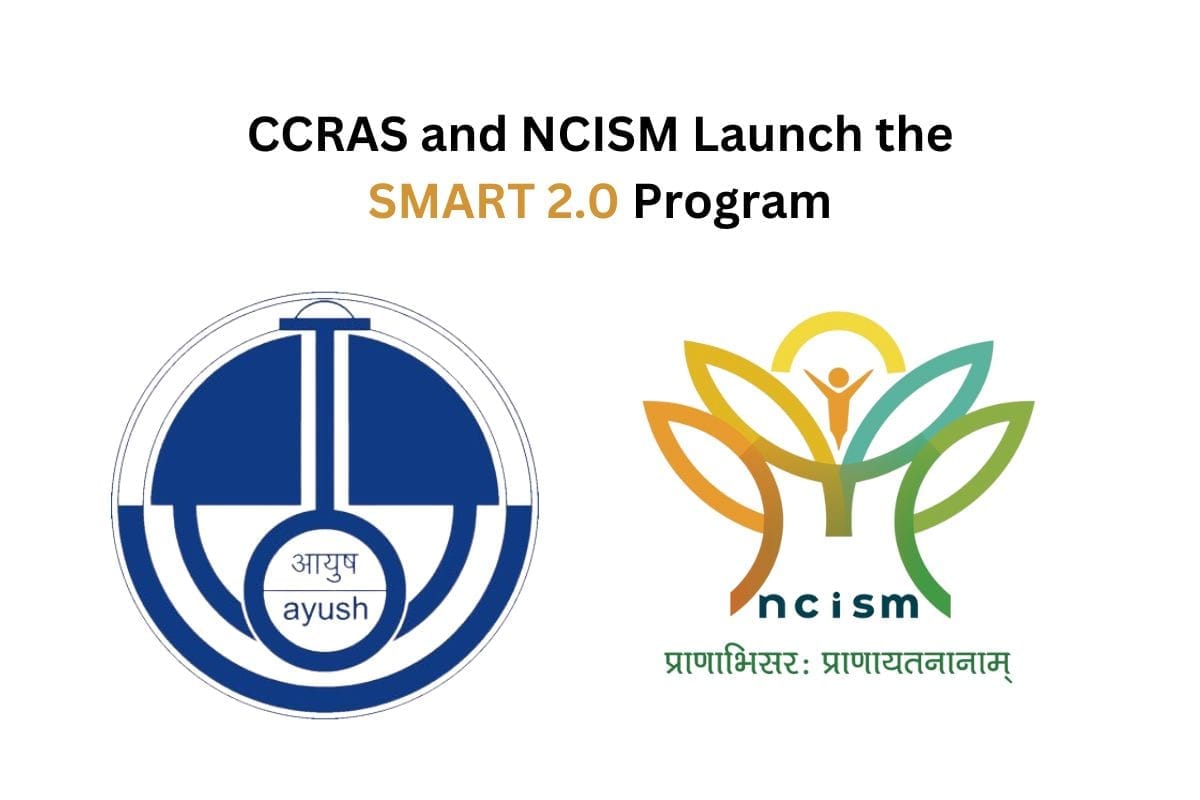
Among the latest current affairs that took place, the Central Council for Research in Ayurvedic Sciences (CCRAS) and the National Commission for Indian System of Medicine (NCISM) launched the ‘SMART 2.0’ program on January 3rd, aiming to promote evidence-based clinical research on priority Ayurveda interventions through collaboration between research bodies and academic institutions.
Key Points:
- ‘SMART’ stands for ‘Scope for Mainstreaming Ayurveda Research among Teaching professionals.’
- Under this initiative, Ayurveda colleges, hospitals, and universities are invited to jointly undertake robust studies showcasing the efficacy and safety of Ayurveda formulations in addressing key healthcare challenges.
News:
The program’s focus areas include pediatrics, women’s health, malnutrition, and lifestyle diseases such as diabetes mellitus and osteoporosis. CCRAS will provide scientific inputs and project monitoring during multi-center trials to ensure rigorous research.
Impact of SMART 2.0:
Despite Ayurveda’s potential, evidence gaps have hindered its integration into public healthcare programs. SMART 2.0 seeks to overcome this challenge by generating tangible validation for Ayurvedic therapies. The success of the earlier SMART 1.0 round in 10 disease areas indicates the effectiveness of this collaborative approach.
Transformation for CCRAS and NCISM:
The SMART 2.0 program signals a growing effort to place Ayurveda on an equal evidence footing within India’s medical mainstream. The collaboration between science and tradition, facilitated by initiatives like SMART, transforms the role of CCRAS and NCISM by actively bridging the gap between modern scientific research and traditional Ayurvedic practices.
This integration aims to pave the way for wider acceptance and adoption of Ayurveda in mainstream healthcare.
Challenges Faced By Ayurveda In Being Integrated Into Public Healthcare Programs
Ayurveda, despite its rich traditional heritage and potential benefits, encounters several challenges in its integration into public healthcare programs. These challenges include:
Lack of Scientific Evidence:
Ayurveda often faces skepticism due to a perceived lack of robust scientific evidence supporting its efficacy. Integrating it into mainstream healthcare requires rigorous research to establish its effectiveness in treating various health conditions.
Standardization and Quality Control:
Ensuring the quality and standardization of Ayurvedic medicines and treatments is a challenge. Establishing standardized practices and quality control measures is crucial to gaining trust within the healthcare system.
Perception and Awareness:
Many people, including healthcare professionals, may not have a comprehensive understanding of Ayurveda. Overcoming misconceptions and raising awareness about its principles and benefits is essential for its acceptance.
Regulatory Framework:
The absence of a well-defined regulatory framework for Ayurveda can hinder its integration into public healthcare programs. Developing and implementing clear regulations will provide a structured pathway for its inclusion.
Collaboration with Modern Medicine:
Integrating Ayurveda into public healthcare requires effective collaboration with modern medicine. Coordinating treatment plans and establishing protocols for combined approaches are necessary for a holistic healthcare system.
Limited Research Funding:
Ayurvedic research often receives limited funding compared to conventional medicine. Increased investment in research will help generate scientific evidence, fostering greater acceptance within the healthcare community.
Workforce Training and Education:
The training and education of healthcare professionals in Ayurvedic practices are vital for successful integration. Developing educational programs and providing continuous training opportunities will ensure a skilled workforce.
Public Perception and Acceptance:
Shifting public perception and gaining acceptance for Ayurvedic treatments may take time. Building trust in Ayurveda’s efficacy and safety among the general population is crucial for successful integration.
Incorporation into Medical Curriculum:
Integrating Ayurvedic principles into the mainstream medical curriculum is essential for producing healthcare professionals who appreciate and understand both traditional and modern approaches to healthcare.
Research Collaboration:
Establishing collaborative research initiatives between Ayurvedic institutions and mainstream medical research bodies will contribute to building a stronger evidence base and promoting cross-disciplinary understanding.
Addressing these challenges requires a concerted effort from healthcare authorities, policymakers, and Ayurvedic practitioners to ensure the successful integration of Ayurveda into public healthcare programs.
In summary, SMART 2.0 emerges as a significant step towards legitimizing Ayurveda through concrete research, thereby impacting the perception and integration of traditional Ayurvedic practices within the broader healthcare landscape in India.
Important Questions For Exams
- What does ‘SMART’ stand for in the context of the SMART 2.0 initiative launched by CCRAS and NCISM?
- Explain the primary objective of the SMART 2.0 program and how it aims to achieve its goals.
- Identify and elaborate on the key focus areas for research under SMART 2.0, highlighting the health issues targeted in the initial phase.
- Describe the role of CCRAS in the SMART 2.0 program, specifically in terms of scientific guidance and project monitoring during multi-center trials.
- Why is there a perceived need for mainstreaming Ayurveda research, and how does SMART 2.0 address this concern?
- Provide examples of lifestyle diseases mentioned in the SMART 2.0 initiative and explain why they are chosen as areas of focus for research.
- Reflect on the impact of SMART 1.0 on Ayurvedic research and how its success in 10 disease areas influences the approach of SMART 2.0.
- Explore the significance of involving Ayurveda teaching institutions across the country in SMART 2.0 and how it contributes to the program’s success.
- Discuss the challenges faced by Ayurveda in being integrated into public healthcare programs and how SMART 2.0 seeks to overcome these challenges.
- In what ways does the SMART 2.0 initiative transform the roles of CCRAS and NCISM, and how does it contribute to bridging the gap between traditional Ayurvedic practices and modern scientific research?


